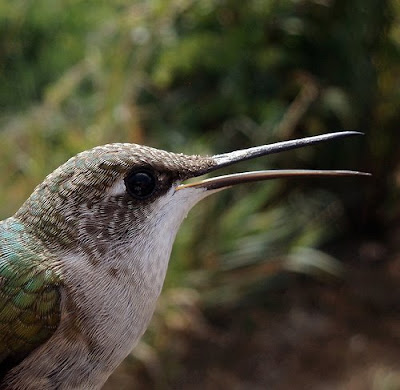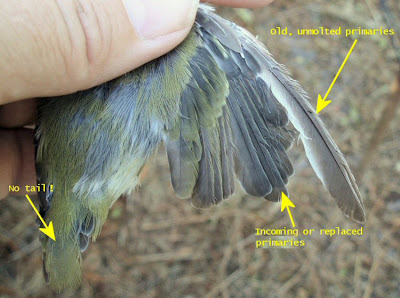Our short week of banding wrapped up with 55 birds being captured, 44 of them new birds. Most were catbirds. I did recapture an adult first banded in 2006 (as well as a Song Sparrow also banded that year). But the majority were young birds. The baby catbirds are still sort of cute, but will soon look really scruffy as they molt into their adult feathers.

The first Wilson's Warbler of the season was in the nets today. Their typical fall arrival date here on campus is 29 August, but the earliest date we've recorded them is 18 August. It's not too unlikely that they may arrive a little earlier, but we ordinarily don't do much field work on campus in July, so they could be overlooked. If you are interested in extreme and typical arrival dates for the common species in southeast Michigan, pick up a copy of my book,
The Birds of Dearborn, An Annotated Checklist. You can have a PDF copy on our desktop in a few minutes for only $5!

The Wilson's was a young female. In a future post, I'll talk about how we age birds. As for determining gender, the nearly complete lack of a dark glossy cap is indicative of a female, as was the length of the wing. In many songbirds, males have longer wings than females. Although there is overlap in most species, extremes can indicate gender.

Another thing to notice in the photo above are her "whiskers" which are actually modified feathers known as "rictal bristles." Many birds have them, but they are most well-developed in species that forage for insects on the wing. The flattish bill shape and prominent (for a warbler) rictal bristles prompted Audubon to refer to this species as "Wilson's Flycatching Warbler."
Today I also caught another molting Tennessee Warbler. It was just as sorry-looking as the
first one, although it was further along with its molt. The photo below shows the obvious contrast between the fresh new and incoming wing feathers and the three older, worn feathers.

At least, this bird had a tail. One thing we note for all Tennessee Warblers is the extent of the white spot on the outer tail feather. Not all of them have a spot; this one was quite large. It's not certain why there is such variation, but perhaps once we get a large enough sample size, we can see if there is any correlation with age, sex, or some aspect of geographic range.

I'll be back at the nets on Monday!
 There are several species that we capture that we release unbanded. One is Ruby-throated Hummingbird (Archilochus colubris). A special permit is required to band hummingbirds, and a project involving them is outside my focus of research. This time of year, most of the ones we catch are immature/female-plumaged birds.
There are several species that we capture that we release unbanded. One is Ruby-throated Hummingbird (Archilochus colubris). A special permit is required to band hummingbirds, and a project involving them is outside my focus of research. This time of year, most of the ones we catch are immature/female-plumaged birds.
 Once again, Gray Catbirds made up most of the catch, and represent half of all the birds handled so far this fall. The pace has been a little slower than most of our fall season starts, but should pick up soon. I'll be back at the nets after the holiday weekend.
Once again, Gray Catbirds made up most of the catch, and represent half of all the birds handled so far this fall. The pace has been a little slower than most of our fall season starts, but should pick up soon. I'll be back at the nets after the holiday weekend.











